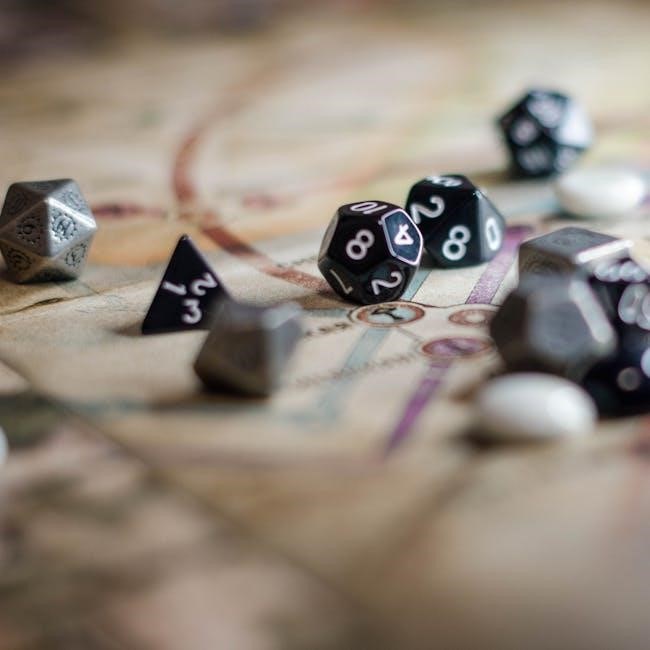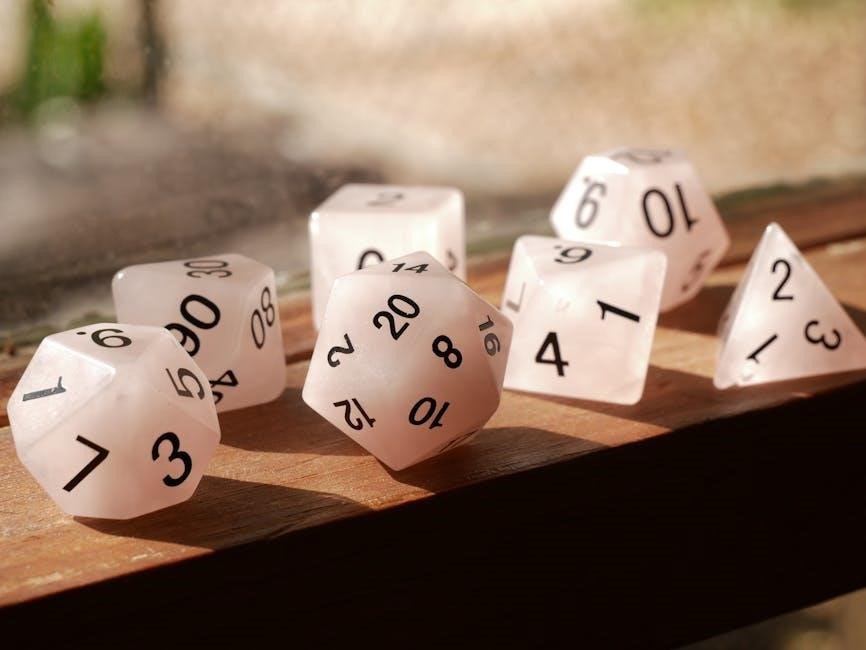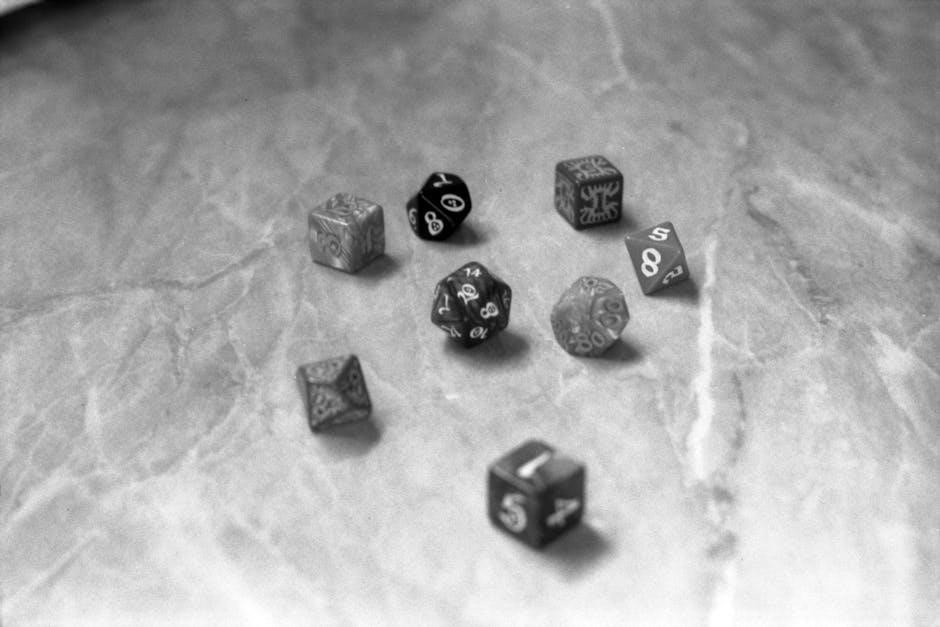2D6 Dungeon is a classic-style, print-and-play, roll-and-write dungeon crawler designed for solo play. Players explore randomly generated rooms, battling monsters and collecting treasure. Each adventure is unique, focusing on a traditional dungeon crawl experience.
The game is available in a convenient print and play format, allowing players to easily access and play the game at home. This accessible format makes 2D6 Dungeon an easy option for solo players seeking a quick, engaging experience.
2D6 Dungeon caters to solo players, offering a streamlined dungeon crawling experience. The game’s mechanics and procedural generation are tailored for solo play, ensuring each adventure is both challenging and rewarding.
Classic Dungeon Crawler Mechanics
2D6 Dungeon embraces classic dungeon crawler mechanics, presenting a streamlined solo experience through randomly generated dungeons. Players explore room by room, encountering various monsters and challenges. Combat is resolved using dice rolls, adding an element of chance and strategy as players choose their actions. As players delve deeper, they gather treasure, gain experience, and enhance their character’s abilities, mirroring traditional RPG progression systems. The game uses a “roll and write” mechanic to record the dungeon’s layout as it’s explored. The print and play format makes it accessible, capturing the essence of old-school dungeon crawling with a modern solo-play twist.
Print and Play Format
2D6 Dungeon’s print and play format provides unparalleled convenience, allowing players to easily access and enjoy the game from home. This format democratizes the dungeon crawling experience, requiring only a printer, dice, and a writing utensil to embark on an adventure. The game’s core rules and components are contained within a readily downloadable PDF, eliminating the need for extensive physical materials. This streamlined approach makes 2D6 Dungeon ideal for impromptu gaming sessions, travel, or situations where traditional tabletop games are impractical. The format encourages players to customize their game by creating character sheets or designing additional dungeon maps. The easy accessibility makes it beginner-friendly.

Overview of 2D6 Dungeon
Solo Play Focus
2D6 Dungeon is designed specifically for solo play, offering a unique dungeon crawling experience tailored for individual adventurers. The game’s mechanics focus on streamlined rules and procedural generation, allowing players to explore randomly generated dungeons without the need for a game master or fellow players. The game emphasizes strategic decision-making, resource management, and character progression. The solo experience encourages creativity, allowing players to fully immerse themselves in the world and create their own narratives. With its focus on solo play, 2D6 Dungeon provides a convenient and engaging way to experience the thrill of a dungeon crawl. Solo play is a great way to pass the time and to test your problem solving skills.
2D6 Dungeon as a Dungeon Generator
2D6 Dungeon can be used to generate interesting dungeon rooms by rolling dice for the room shape and number of exits. It is perfect for generating dungeons on the fly for solo adventures.
Using 2D6 Dungeon for Room Generation
2D6 Dungeon excels as a tool for procedurally generating dungeon rooms, offering a dynamic and unpredictable experience. By utilizing dice rolls, players can determine various aspects of each room, including its shape, contents, and number of exits. Rolling 2D6 for room shape ensures there is organic look in the dungeon. This creates a unique and ever-expanding dungeon layout.
The system is designed to unfold as playing, and it has a zero prep way to play a dungeon crawl solo or co-op. Variations might include pre-defined dungeon segments in place of a text-based table, making it a versatile dungeon generator.
Pairing with Other RPG Systems
2D6 Dungeon’s room generation system can be seamlessly integrated with other RPG systems like GURPS, OSE, or Mythic GME2. Players can use 2D6 Dungeon solely for its dungeon generation capabilities, creating unique environments for their preferred ruleset. This allows for a customizable and flexible gaming experience, merging the procedural generation of 2D6 Dungeon with the mechanics of other RPGs.
Pairing 2D6 Dungeon with other systems lets you use other sources for room flavors and trappings. For example, you can use 2D6 Dungeon for the dungeon layout, and OSE for the room contents. The best of both worlds!

Procedural Dungeon Generation Techniques
Roll dice to determine the contents of each room. A 1d6 can determine room contents, such as traps. This ensures a unique and unpredictable dungeon environment with each new adventure, making game play a unique experience.
Use dice rolls, such as 2d6, to define the shape of each room, which could be oval or square. This random generation technique adds variety and unpredictability to the dungeon layout, creating a unique gaming experience.
Roll dice, like 1d4, to determine the number of doors or exits. Procedural generation ensures that each dungeon is unique, encouraging exploration and discovery. The unpredictable nature of exit placement enhances strategic decision-making.
Dice Rolling for Room Contents
To populate the dungeon rooms with interesting features, 2D6 Dungeon utilizes dice rolling to determine room contents. Roll a 1d6 to determine what the players find in each room. For example, the dice roll might indicate a pit trap, treasure chest, or a hidden passage. This method ensures variety and unpredictability in the dungeon’s design.
The dice rolling system offers a streamlined approach to content generation, allowing game masters to quickly populate rooms without extensive preparation. By assigning different outcomes to each number on the die, a diverse range of encounters and discoveries can be easily implemented.
This random element keeps players on their toes, encouraging them to explore rooms carefully and consider potential dangers. This simple method creates a unique and engaging experience.
Dice Rolling for Room Shape
In 2D6 Dungeon, the shape of each room is determined by rolling 2d6. This process ensures a varied and organic dungeon layout. The dice roll determines the shape, such as a square, oval, or irregular form. The dice rolling mechanic adds an element of chance and unpredictability to the dungeon’s architecture.
Different results on the 2d6 table can correspond to distinct room shapes, creating a diverse and engaging environment for players to explore. The organic look of the dungeon creates a sense of realism.
This simple process eliminates the need for pre-designed maps and allows for a dynamic and ever-changing dungeon experience. The players will have to adapt to each new room.
Dice Rolling for Number of Exits
The number of exits in each room within 2D6 Dungeon is determined using dice rolls, typically a 1d4 or 2d6. This ensures a varied dungeon layout with rooms offering few or multiple escape routes. Rolling for exits adds an element of unpredictability, forcing players to adapt their strategies.
A low roll might result in a dead end, while a high roll could lead to a chamber with numerous corridors. This mechanic makes exploration more engaging and less predictable. The exit generation adds a sense of realism.
The dice rolling process provides dynamic exploration. Randomness makes each dungeon experience unique, requiring players to think strategically about movement.

Available 2D6 Dungeon Resources
2D6 Dungeon resources are available as PDF downloads, including the core rules and character sheets. This accessibility allows players to easily print and play the game at their convenience, fostering ease of use.
PDF Downloads
The core rules for 2D6 Dungeon, character sheets, and supplementary materials are readily available as PDF downloads. This format allows players to easily access and print the game components for convenient play. Several resources are available in the files section.
These downloadable PDFs provide everything needed to start playing 2D6 Dungeon, including rules, character sheets, and example adventures. The print-and-play nature of the game makes it highly accessible for solo players or those looking for a quick dungeon crawling experience.
These PDFs allow users to print the game and play it solo. These also include character sheets.
Online Generators and Tools
To enhance the 2D6 Dungeon experience, online generators and tools have emerged, offering players additional resources for creating unique adventures. These include tools for random NPC generation, loot tables, magic items, and even full dungeon layouts.
A web application exists for creating custom enemies, allowing players to design and save their own creatures as PNG files. These tools can greatly reduce prep time and add variety to gameplay. The online Dungeon Map Generator provides ready-to-use maps.
These tools provide a convenient way to enhance the game! There is also a dungeon generator to help with the game.
Customization and Expansion
Players can create custom enemies using online tools, designing unique creatures. This adds depth to the game. Custom enemies enhance the player’s adventure, providing new challenges.
Character sheets can be modified. This allows for tailored gameplay. Players can adjust the sheets to better suit their play style. This expansion allows for a greater player experience.
Creating Custom Enemies
2D6 Dungeon allows you to craft unique enemies using available resources. You can use online tools for 2D6 Dungeon to make custom enemy cards. These cards can be saved as PNG files. A print template is available for these cards. This provides an additional creative outlet for players. You are able to design the enemies’ stats and abilities. Creating custom enemies allows you to tailor the experience and the challenge. You are able to introduce new monsters to your dungeons. This allows for a personalized gameplay experience. Custom enemies allow you to modify the dungeon experience. This is great for creating a unique adventure. This is beneficial for solo players. It allows them to create unique challenges. This gives 2D6 Dungeon greater replayability. You can change the game to suit your preferences.
Modifying Character Sheets
Enhance your 2D6 Dungeon experience by modifying character sheets. Creating personalized character sheets allows for a customized approach to gameplay. You may condense the original character sheet for a more compact design. Tailoring character sheets enables players to focus on key information. This helps streamline the game play. This personalization can improve organization. You can also improve gameplay efficiency. You can incorporate additional character options. Modifying character sheets allows for greater flexibility in character development. This enhances the solo play experience by matching personal preferences. Experiment with different layouts and data tracking methods. These modifications can add depth to your game. You can customize them to your liking. These altered sheets can make gameplay more efficient. Make the most of your adventures. Altering character sheets increases engagement. It provides a customized approach to gameplay. You can tailor them for solo play.

Community and Support
2D6 Dungeon gained traction through Kickstarter, demonstrating community interest. Kickstarter campaigns help fund development and expansions. These campaigns foster a community of players and supporters around the game.
Engage with other players through online forums and groups. These platforms enable sharing experiences and strategies. Connecting with the community enhances the 2D6 Dungeon experience and offers support.
Kickstarter Campaigns
2D6 Dungeon has a history of successful Kickstarter campaigns, demonstrating a strong community interest and support for the game. These campaigns were crucial in bringing the game to life and funding expansions. Backers contributed to development, receiving rewards like exclusive content and early access.
The campaigns served as a platform to showcase the game’s unique features, including its classic dungeon crawler mechanics and solo play focus. Through Kickstarter, the creator, Toby Lancaster, fostered a dedicated community, ensuring ongoing support and feedback. The success of the Kickstarter campaigns reflects the game’s appeal and potential within the tabletop gaming community. These campaigns are a great way to support the creator.
Online Forums and Groups
Online forums and groups provide a valuable space for 2D6 Dungeon players to connect, share experiences, and offer support. These platforms allow players to discuss strategies, house rules, and custom content. Players can find advice, resolve rules questions, and share their solo play experiences.
These online communities often serve as a hub for sharing custom-designed enemies, modified character sheets, and other player-created content. Forums enable collaborative problem-solving and innovative gameplay. They foster a sense of community among solo players, who can find encouragement and inspiration in shared experiences. The presence of active forums demonstrates the game’s strong following and collaborative spirit. These groups are a great way to find and share tips.
